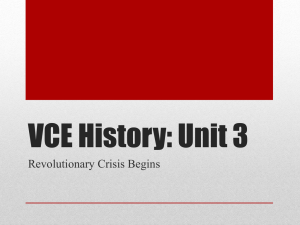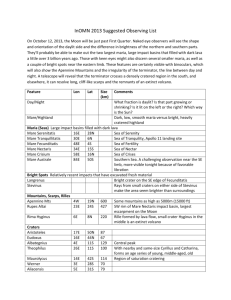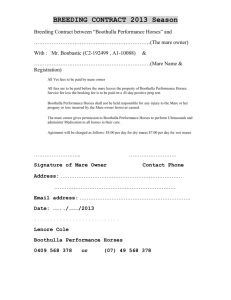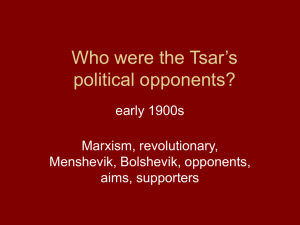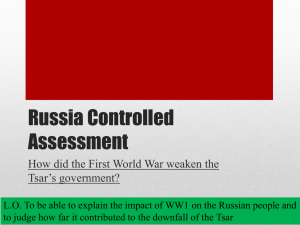Golden Mare the Firebird and the Magic Ring Placemat
advertisement
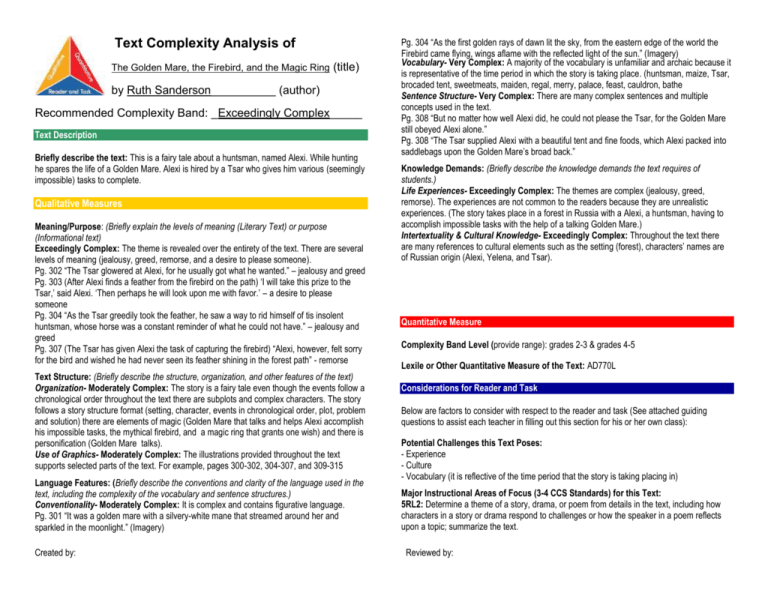
Text Complexity Analysis of The Golden Mare, the Firebird, and the Magic Ring (title) by Ruth Sanderson__________ (author) Recommended Complexity Band: _Exceedingly Complex_____ Text Description Briefly describe the text: This is a fairy tale about a huntsman, named Alexi. While hunting he spares the life of a Golden Mare. Alexi is hired by a Tsar who gives him various (seemingly impossible) tasks to complete. Qualitative Measures Meaning/Purpose: (Briefly explain the levels of meaning (Literary Text) or purpose (Informational text) Exceedingly Complex: The theme is revealed over the entirety of the text. There are several levels of meaning (jealousy, greed, remorse, and a desire to please someone). Pg. 302 “The Tsar glowered at Alexi, for he usually got what he wanted.” – jealousy and greed Pg. 303 (After Alexi finds a feather from the firebird on the path) ‘I will take this prize to the Tsar,’ said Alexi. ‘Then perhaps he will look upon me with favor.’ – a desire to please someone Pg. 304 “As the Tsar greedily took the feather, he saw a way to rid himself of tis insolent huntsman, whose horse was a constant reminder of what he could not have.” – jealousy and greed Pg. 307 (The Tsar has given Alexi the task of capturing the firebird) “Alexi, however, felt sorry for the bird and wished he had never seen its feather shining in the forest path” - remorse Text Structure: (Briefly describe the structure, organization, and other features of the text) Organization- Moderately Complex: The story is a fairy tale even though the events follow a chronological order throughout the text there are subplots and complex characters. The story follows a story structure format (setting, character, events in chronological order, plot, problem and solution) there are elements of magic (Golden Mare that talks and helps Alexi accomplish his impossible tasks, the mythical firebird, and a magic ring that grants one wish) and there is personification (Golden Mare talks). Use of Graphics- Moderately Complex: The illustrations provided throughout the text supports selected parts of the text. For example, pages 300-302, 304-307, and 309-315 Language Features: (Briefly describe the conventions and clarity of the language used in the text, including the complexity of the vocabulary and sentence structures.) Conventionality- Moderately Complex: It is complex and contains figurative language. Pg. 301 “It was a golden mare with a silvery-white mane that streamed around her and sparkled in the moonlight.” (Imagery) Created by: Pg. 304 “As the first golden rays of dawn lit the sky, from the eastern edge of the world the Firebird came flying, wings aflame with the reflected light of the sun.” (Imagery) Vocabulary- Very Complex: A majority of the vocabulary is unfamiliar and archaic because it is representative of the time period in which the story is taking place. (huntsman, maize, Tsar, brocaded tent, sweetmeats, maiden, regal, merry, palace, feast, cauldron, bathe Sentence Structure- Very Complex: There are many complex sentences and multiple concepts used in the text. Pg. 308 “But no matter how well Alexi did, he could not please the Tsar, for the Golden Mare still obeyed Alexi alone.” Pg. 308 “The Tsar supplied Alexi with a beautiful tent and fine foods, which Alexi packed into saddlebags upon the Golden Mare’s broad back.” Knowledge Demands: (Briefly describe the knowledge demands the text requires of students.) Life Experiences- Exceedingly Complex: The themes are complex (jealousy, greed, remorse). The experiences are not common to the readers because they are unrealistic experiences. (The story takes place in a forest in Russia with a Alexi, a huntsman, having to accomplish impossible tasks with the help of a talking Golden Mare.) Intertextuality & Cultural Knowledge- Exceedingly Complex: Throughout the text there are many references to cultural elements such as the setting (forest), characters’ names are of Russian origin (Alexi, Yelena, and Tsar). Quantitative Measure Complexity Band Level (provide range): grades 2-3 & grades 4-5 Lexile or Other Quantitative Measure of the Text: AD770L Considerations for Reader and Task Below are factors to consider with respect to the reader and task (See attached guiding questions to assist each teacher in filling out this section for his or her own class): Potential Challenges this Text Poses: - Experience - Culture - Vocabulary (it is reflective of the time period that the story is taking placing in) Major Instructional Areas of Focus (3-4 CCS Standards) for this Text: 5RL2: Determine a theme of a story, drama, or poem from details in the text, including how characters in a story or drama respond to challenges or how the speaker in a poem reflects upon a topic; summarize the text. Reviewed by: 5RL3: Compare and contrast two or more characters, setting, or events in a story or drama, drawing on specific details in the text (e.g., how characters interact). 5RL4: Determine the meaning of words and phrases as they are used in a text, including figurative language such as metaphors and similes. Differentiation/Supports for Students: - Introduce vocabulary from the story - Frontload vocabulary and phrases - Chunk the text - Graphic Organizer: flow map - Use retelling cards - Pre-read - Pre-teach point of view - Review fiction - Review story structure - Summarize Recommended Placemat: Briefly explain the recommended placement of the text in a particular grade band. Based on the analysis of the text, the recommended placemat is for the middle of the year for 5th grade. Created by: Reviewed by:

